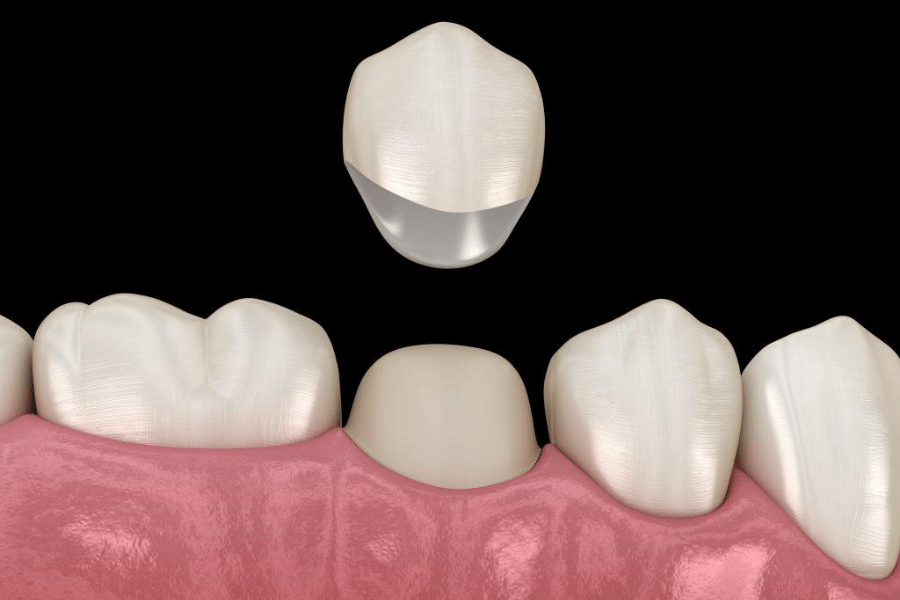Dental Crowns
 Crowns are similar to veneers but work on teeth that are weaker, more brittle, or worn. Unlike veneers, a crown (or cap) is a covering that encases the entire tooth. A crown serves to protect and strengthen a tooth that has had a root canal performed or a tooth that cannot be restored with any other type of treatment. Crowns are an excellent choice for restoring tooth structure and should provide many years of good service.
Crowns are similar to veneers but work on teeth that are weaker, more brittle, or worn. Unlike veneers, a crown (or cap) is a covering that encases the entire tooth. A crown serves to protect and strengthen a tooth that has had a root canal performed or a tooth that cannot be restored with any other type of treatment. Crowns are an excellent choice for restoring tooth structure and should provide many years of good service.
For more information, please visit the Canadian Dental Association website.
The Benefits of Porcelain Crowns
Dental crowns, also called caps, fit over worn or damaged teeth. They can also serve a cosmetic purpose, restoring a discolored tooth to its former hue. Your dentist may fit you with a temporary crown to protect a damaged tooth while you wait for a permanent crown. Depending on the material used to make them, the wear they get, and the care they receive, permanent crowns last about 5 to 15 years.
Who Needs Dental Crowns?
Crowns serve many purposes in restorative and cosmetic dentistry. They are an integral part of providing support to weakened or broken teeth. Untreated dental problems can lead to jaw pain, headaches, and bite anomalies that could further damage otherwise healthy teeth.
When Your Dentist Will Recommend Crowns:
- Protecting soft or weakened teeth
- Supporting extensively filled teeth
- Anchoring bridgework
- Restoring the appearance of misshapen, chipped, or discolored teeth
- Covering a dental implant
- Rebuilding a tooth after a root canal
- Creating a healthy bite
Types of Crowns
Dental crowns fall into three categories: full metal, porcelain fused to metal, and porcelain. Your dentist will assess your dental health and discuss your options with you, but all three crown types have distinct advantages.
All-Metal Crowns
Precious metals have tremendous durability and are non-reactive. These characteristics make them a preferred material for dental crowns. Gold alloys are the most common metal for crowns. Metal crowns offer outstanding longevity, but because they look nothing like natural tooth enamel, they are most often used for molars where they will not be as visible. With the rising costs of precious metals these crowns are the most expensive.
PMF Crowns
Porcelain fused to metal (PFM) crowns conceal metallic surfaces under a ceramic layer that closely resembles natural tooth enamel. Because of their metal cores, these crowns reveal their underlying structure in strong light and lack the translucency of natural teeth. There are instances where the porcelain can also fracture off of the metal substructure of the crown.
All-Porcelain Crowns
Porcelain crowns have the most natural look and are generally indistinguishable from natural teeth. Due to advancements in ceramics, they are every bit as strong as metal or PFM crowns. New CAD/CAM techniques allow dentists to create crowns in minutes, but the procedure is typically costly. Porcelain crowns made in this way will wear at the same rate as natural teeth.
How Crowns Are Applied
Your dentist will give you a local anesthetic to numb the area before preparing teeth to receive crowns. Biting on carbon paper shows how your teeth meet, ensuring the height will not interfere with your bite. After the bite impression, you will be fitted with a dental dam to protect the rest of your mouth from tooth dust and to keep the restoration site dry. With a high-speed drill, the dentist will then reshape any teeth needing crowns. Reshaping may involve minor filing, or it could necessitate the removal of more material in order to leave a peg-like anchor point for the crown. The amount of your natural tooth that must be removed depends on the type of crown you’re getting and the reason for the restoration.
After shaping the tooth to prepare it for the crown, your dentist will take another bite impression. This step is essential when making the cap fit the remaining tooth perfectly. If you are getting same-day porcelain crowns, you have only a 20-minute wait. Metal and PFM crowns will take more time to prepare. During your wait, you will get a temporary acrylic crown and then return in a few weeks to get the permanent crown fitted. In either case, the dentist will apply cement to the crown and press it into place.
If you get temporary crowns, ask your dentist about specific care requirements until the permanent crowns are ready. Some common precautions to take with temporary crowns include:
- Chewing on the other side of your mouth
- Avoiding caramel, toffee, and other sticky foods that could loosen the dental work
- Sliding floss from between the crowned teeth instead of lifting it free
Caring for Dental Crowns
Your new crowns look, feel, and behave like your natural teeth, so they need the same care. Follow the brushing and flossing schedule your dentist recommends. Metal-based crowns may feel more sensitive to heat and cold initially but should adjust quickly. Contact your dentist if you notice the following concerns after receiving crowns:
- Difficulty or pain when chewing
- Pain in your head or jaw
- Loosening or wiggling of the crown
- Rough or jagged spots that could indicate a chipped porcelain crown